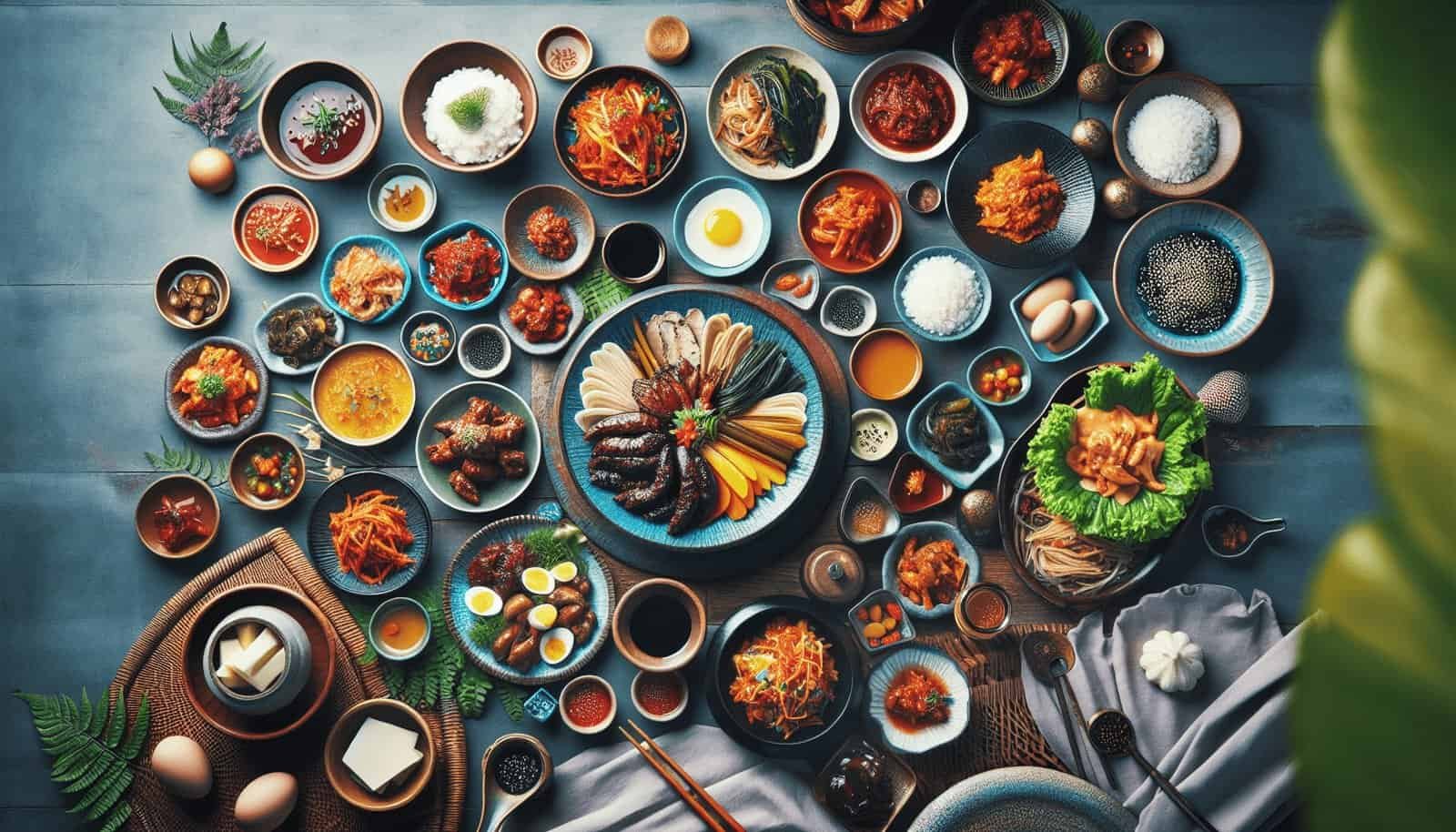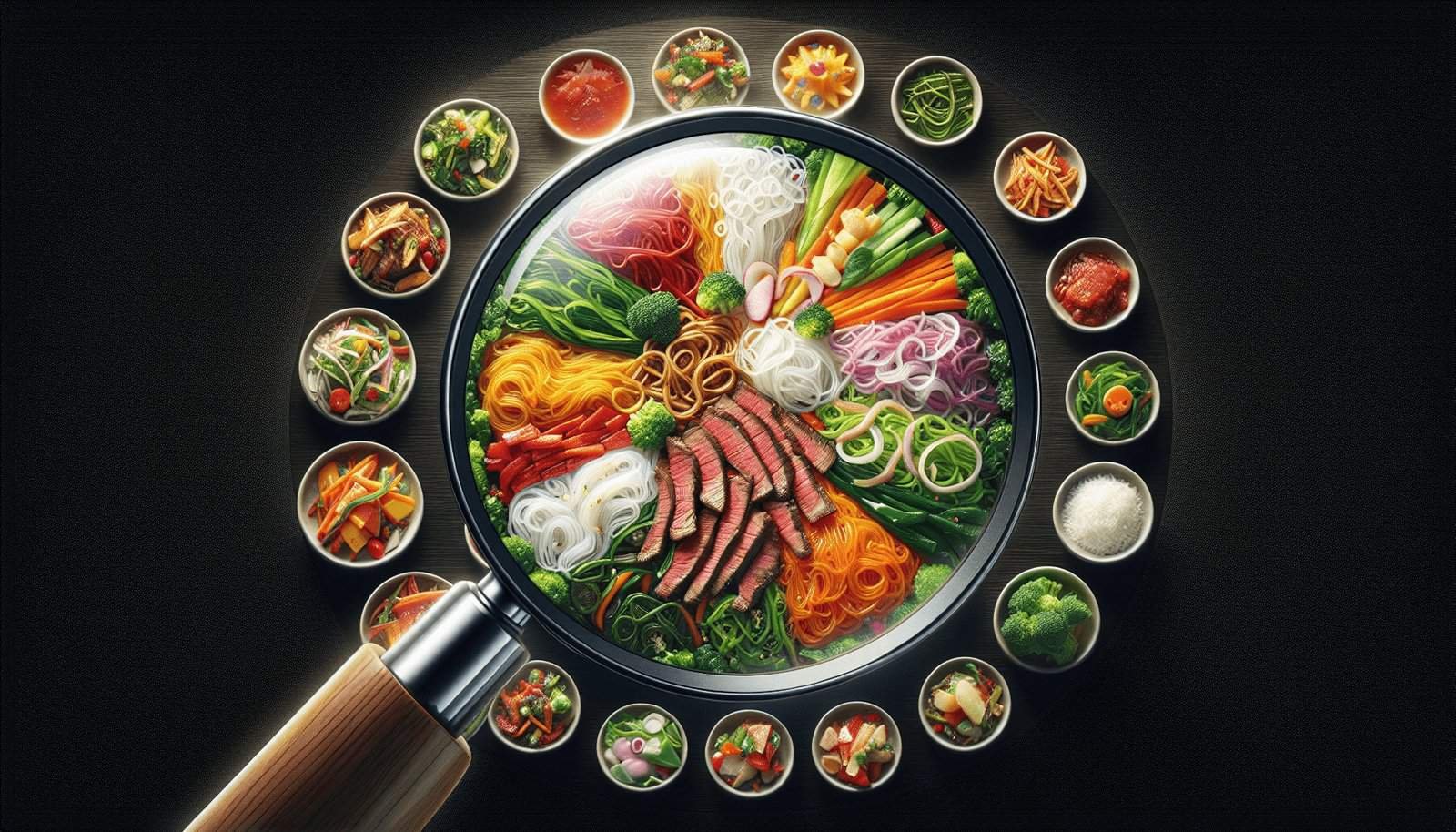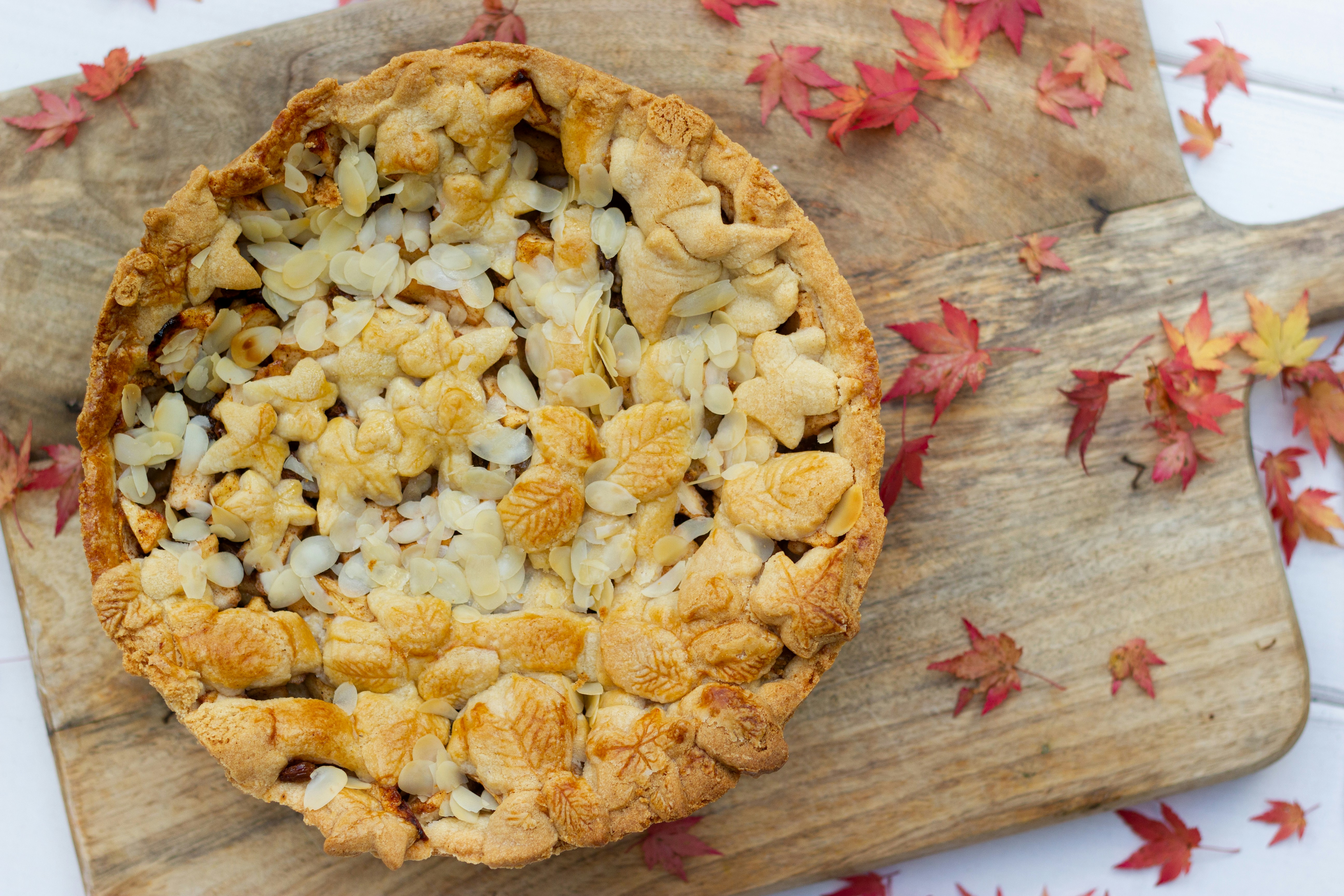Have you ever wondered about the traditional Korean dishes that are cherished and celebrated during festive occasions? From vibrant and flavorful dishes like Kimchi, Bibimbap, and Bulgogi, to mouthwatering desserts like Tteok and Yakgwa, Korean cuisine is full of delightful options that are often enjoyed during special celebrations. Whether you’re attending a wedding, Lunar New Year, or Chuseok, these festive dishes not only bring people together but also showcase the rich tapestry of Korean culture. So, get ready to tantalize your taste buds and immerse yourself in the joy of Korean celebrations as we explore some of the most recommended traditional dishes for festive occasions.
Japchae (잡채)
Overview
Japchae is a traditional Korean dish that is often served during festive occasions or celebrations. It is a stir-fried noodle dish that consists of sweet potato glass noodles, various vegetables, and sometimes meat. Japchae is known for its vibrant colors and the harmonious combination of flavors that make it a crowd-pleaser.
Ingredients
The key ingredients in japchae include:
- Sweet potato glass noodles (dangmyeon)
- Vegetables such as carrots, mushrooms, spinach, and bell peppers
- Meat (optional) such as beef, chicken, or pork
- Soy sauce
- Sesame oil
- Sugar
- Garlic
- Sesame seeds
Preparation
To prepare japchae, start by soaking the sweet potato glass noodles in cold water for about 30 minutes until they soften. Meanwhile, julienne the vegetables and thinly slice the meat if using. In a pan, heat some oil and stir-fry the vegetables and meat separately until cooked. Then, drain the noodles and boil them until they are tender. In a large bowl, combine the cooked noodles, vegetables, and meat. In a separate small bowl, mix soy sauce, sesame oil, sugar, garlic, and sesame seeds to make a flavorful sauce. Pour the sauce over the noodle mixture and toss well to coat everything.
Serving and Presentation
Japchae is typically served either warm or at room temperature. It is often garnished with additional sesame seeds or chopped green onions for extra flavor and visual appeal. The dish can be enjoyed on its own as a main course, or it can be served as a side dish alongside other Korean delicacies. Japchae is not only delicious but also visually stunning, making it an excellent addition to any festive table.
Bulgogi (불고기)
Overview
Bulgogi is a classic Korean dish that is often enjoyed during special occasions or celebrations. It is a grilled or stir-fried meat dish, traditionally made with thinly sliced beef marinated in a flavorful sauce. The name “bulgogi” translates to “fire meat” in English, referring to the intense heat used in the cooking process.
Ingredients
The main ingredients for bulgogi are:
- Thinly sliced beef (typically sirloin or tenderloin)
- Soy sauce
- Sugar
- Sesame oil
- Garlic
- Ginger
- Black pepper
Marinade
To make the marinade for bulgogi, mix soy sauce, sugar, sesame oil, minced garlic, minced ginger, and black pepper in a bowl. This marinade helps to tenderize the meat and infuse it with delicious flavors.
Cooking Techniques
Bulgogi can be cooked using different methods, including grilling, pan-frying, or stir-frying. If grilling, preheat the grill and place the marinated beef slices onto the hot grill, cooking them for a few minutes on each side until they are cooked to your desired degree of doneness. Alternatively, the marinated beef can be stir-fried in a heated pan or wok until it is cooked through. Whichever cooking method you choose, be sure not to overcook the beef to maintain its tenderness and juiciness.
Serving and Accompaniments
Bulgogi is typically served with a variety of accompaniments to create a balanced and satisfying meal. It is often enjoyed wrapped in lettuce leaves, along with rice, kimchi (fermented vegetables), and other side dishes. The flavorful beef, combined with the crisp lettuce and spicy kimchi, creates a delightful combination of textures and flavors. Bulgogi is a popular choice for celebratory meals due to its delicious taste and versatility.
Galbijjim (갈비찜)
Overview
Galbijjim is a traditional Korean dish that is commonly served during festive occasions or celebrations. It is a braised beef short rib dish that is marinated in a savory and slightly sweet sauce. Galbijjim is known for its tender meat and rich flavors, making it a favorite among Korean cuisine lovers.
Ingredients
The key ingredients for galbijjim include:
- Beef short ribs
- Soy sauce
- Sugar
- Garlic
- Ginger
- Sesame oil
- Rice wine (mirin)
- Korean pear
- Carrots
- Chestnuts (optional)
Preparation
To prepare galbijjim, start by soaking the beef short ribs in cold water for about 30 minutes to remove any blood. Meanwhile, make the marinade by combining soy sauce, sugar, minced garlic, minced ginger, sesame oil, rice wine, and grated Korean pear in a bowl. Once the short ribs are soaked, drain them and place them in a large pot. Pour the marinade over the ribs, add sliced carrots and chestnuts if desired, and bring the mixture to a boil. Reduce the heat, cover the pot, and let it simmer for about 1.5 to 2 hours until the meat is tender and falls off the bone.
Cooking Techniques
Galbijjim is a slow-cooked dish that is typically braised over low heat to allow the flavors to meld together and the meat to become tender. The long cooking time ensures that the beef absorbs all the flavors of the marinade, resulting in a delicious and succulent dish.
Serving and Accompaniments
Galbijjim is traditionally served with steamed white rice, as the rice helps to balance out the richness of the dish. It is often garnished with chopped green onions and sesame seeds for added flavor and presentation. Galbijjim pairs well with other Korean side dishes such as kimchi, braised vegetables, and pickled radish. This hearty and flavorful dish is sure to impress your guests during festive occasions.
Samgyetang (삼계탕)
Overview
Samgyetang is a popular Korean dish that is commonly enjoyed during special events or celebrations. It is a nutritious and hearty soup made with a whole young chicken stuffed with rice and medicinal herbs. Samgyetang is believed to have restorative properties and is often consumed during the hot summer months to boost energy and promote overall well-being.
Ingredients
The main ingredients for samgyetang are:
- Whole young chicken
- Sticky rice
- Garlic cloves
- Jujubes (Korean dates)
- Ginseng root
- Korean ginseng powder (optional)
- Ginkgo nuts (optional)
Preparation
To prepare samgyetang, start by thoroughly cleaning the young chicken and removing any excess fat. Rinse the sticky rice and soak it in cold water for about one hour. Stuff the cavity of the chicken with the soaked rice, garlic cloves, jujubes, and ginseng root. Place the stuffed chicken in a pot, along with any additional optional ingredients such as ginkgo nuts. Add enough water to cover the chicken and bring the pot to a boil. Reduce the heat to low and let the soup simmer for approximately 1.5 to 2 hours until the chicken is fully cooked and the rice has absorbed the flavors.
Serving and Condiments
Samgyetang is traditionally served piping hot in individual bowls. The dish is often accompanied by various condiments such as salt, black pepper, and chopped green onions. These condiments can be added to taste, allowing each person to customize their samgyetang according to their preferences. It is common to enjoy the soup alongside a side of kimchi and a bowl of steamed rice. Samgyetang’s nourishing qualities and comforting flavors make it an ideal choice for festive occasions or when you’re looking for a satisfying and revitalizing meal.
Jajangmyeon (자장면)
Overview
Jajangmyeon is a beloved Korean dish that is often enjoyed during festive or celebratory moments. It is a hearty noodle dish that features thick wheat noodles topped with a rich and savory black bean sauce. Jajangmyeon is a popular comfort food in Korea, and it has become an iconic dish that brings people together to celebrate.
Ingredients
The main ingredients for jajangmyeon include:
- Thick wheat noodles (jajangmyeon noodles)
- Pork or beef
- Black bean paste (chunjang)
- Various vegetables such as onions, zucchini, and potatoes
- Soy sauce
- Sugar
- Oil
Preparation
To prepare jajangmyeon, start by cooking the thick wheat noodles according to the package instructions. While the noodles are cooking, heat some oil in a large wok or pan and stir-fry the meat until it is cooked through. Add the chopped onions and continue to cook until they become translucent. Then, add the black bean paste, soy sauce, and sugar, stirring everything together to create a fragrant sauce. Finally, add the rest of the vegetables and simmer until they are tender.
Serving and Garnishes
Jajangmyeon is typically served in large bowls, with the thick wheat noodles forming a bed for the rich black bean sauce and vegetables. It is often garnished with sliced cucumbers and served with a side of pickled radish. The combination of the chewy noodles, bold flavors of the black bean sauce, and the crunch of the fresh garnishes creates a truly satisfying and enjoyable eating experience. Jajangmyeon is a must-try dish when you want to celebrate and indulge in the delicious flavors of Korean cuisine.
Sundubu-jjigae (순두부찌개)
Overview
Sundubu-jjigae is a flavorful and comforting Korean stew that is often enjoyed during festive or celebratory occasions. It is a spicy tofu stew that features soft tofu (sundubu) cooked in a rich and spicy broth with various vegetables and seafood or meat. Sundubu-jjigae is known for its bold and robust flavors, making it a popular choice for those looking for a satisfying meal.
Ingredients
The main ingredients for sundubu-jjigae are:
- Soft tofu (sundubu)
- Seasoned broth or dashi stock
- Vegetables such as onions, zucchini, and mushrooms
- Gochujang (Korean chili paste)
- Soy sauce
- Garlic
- Seafood or meat (optional)
- Egg (optional)
Preparation
To prepare sundubu-jjigae, start by heating seasoned broth or dashi stock in a pot until it comes to a boil. Add gochujang, soy sauce, and minced garlic into the broth, stirring to combine and create a flavorful base. Then, add the tofu and gently simmer for a few minutes until it is heated through. If desired, add seafood or meat to the stew and cook until they are fully cooked. Finally, add the vegetables and cook until they are tender.
Serving and Accompaniments
Sundubu-jjigae is traditionally served in individual earthenware pots, which help to retain heat and enhance the flavors of the stew. The stew can be enjoyed on its own or served with a bowl of steamed rice. Sundubu-jjigae is often garnished with a cracked egg, which can be added to the hot stew just before serving. The egg adds an extra richness to the dish as it cooks in the bubbling broth. Sundubu-jjigae is the perfect dish to warm your soul during festive gatherings.
Tteokguk (떡국)
Overview
Tteokguk is a traditional Korean dish that is closely associated with festive or celebratory occasions, especially the Lunar New Year. It is a hearty soup made with sliced rice cakes (tteok) in a flavorful beef broth. Tteokguk is not only delicious but also holds symbolic meaning as it represents luck, longevity, and renewal.
Ingredients
The main ingredients for tteokguk are:
- Sliced rice cakes (garaetteok)
- Beef broth or anchovy-kelp broth
- Sliced beef
- Eggs
- Sesame oil
- Soy sauce
- Garnishes such as sliced green onions and roasted seaweed
Preparation
To prepare tteokguk, start by boiling the beef broth or anchovy-kelp broth in a pot until it comes to a simmer. Add the sliced rice cakes and sliced beef, cooking until the rice cakes are tender and the beef is cooked through. In a separate bowl, whisk the eggs and drizzle them into the soup, stirring gently until they are cooked. Season the soup with sesame oil and soy sauce according to taste.
Serving and Garnishes
Tteokguk is traditionally served in individual bowls, with the sliced rice cakes and beef submerged in the flavorful broth. It is common to garnish the soup with sliced green onions and roasted seaweed, which adds both aesthetic appeal and additional flavors. Tteokguk is often enjoyed during the Lunar New Year as a symbol of good luck for the coming year. It is believed that eating tteokguk will help one age gracefully and bring blessings for prosperity. So, gather your loved ones and celebrate with a comforting bowl of tteokguk!
Jeon (전)
Overview
Jeon is a popular Korean dish that is often enjoyed during festive or celebratory moments, such as holidays or special gatherings. It is a savory pancake made with a variety of ingredients, such as seafood, vegetables, or meat, mixed with a simple batter and pan-fried to crispy perfection. Jeon is a versatile and crowd-pleasing dish that can be enjoyed as an appetizer or a main course.
Ingredients
The main ingredients for jeon can vary depending on personal preferences, but common ingredients include:
- Seafood such as shrimp, squid, or clams
- Vegetables such as scallions, carrots, or zucchini
- Meat such as beef, pork, or chicken
- Flour
- Egg
- Water
- Salt
- Vegetable oil for frying
Preparation
To prepare jeon, start by preparing the ingredients. Clean and devein any seafood, thinly slice the vegetables, and cut the meat into bite-sized pieces. In a bowl, mix flour, egg, water, and salt to create a smooth batter. Dip each ingredient into the batter, coating it evenly, and then pan-fry in hot oil until golden brown and crispy. Be sure to cook in batches, giving each jeon enough space to cook properly without overcrowding the pan.
Serving and Dipping Sauce
Jeon is typically served as a communal dish, with several different types of jeon arranged on a platter to be shared among the diners. It is often accompanied by a flavorful dipping sauce, such as soy sauce mixed with vinegar and sesame oil, to enhance the flavors of the jeon. This combination of crispy texture, varied ingredients, and the delicious dipping sauce makes jeon a popular choice for festive gatherings, where everyone can enjoy a taste of Korean comfort food.

Bibimbap (비빔밥)
Overview
Bibimbap is a vibrant and flavorful Korean dish that is often enjoyed during festive or celebratory occasions. The name “bibimbap” translates to “mixed rice” in English, highlighting the dish’s signature feature of combining various ingredients over a bed of steamed rice. Bibimbap is a feast for both the eyes and the taste buds, with its colorful presentation and harmonious flavors.
Ingredients
The main ingredients for bibimbap include:
- Steamed short-grain rice
- Assorted vegetables such as carrots, spinach, bean sprouts, and mushrooms
- Protein options such as beef, chicken, or tofu
- Gochujang (Korean chili paste)
- Sesame oil
- Soy sauce
- Garlic
- Eggs (optional)
- Sesame seeds
Preparation
To prepare bibimbap, start by cooking the rice according to the package instructions. Meanwhile, julienne the vegetables and cook them separately until they are tender. Sauté the protein option with some garlic and soy sauce until cooked through. Once the rice and toppings are ready, assemble the bibimbap by placing a scoop of rice in a bowl, arranging the cooked vegetables and protein on top, and adding a dollop of gochujang for a spicy kick. Drizzle sesame oil over the dish and sprinkle with sesame seeds.
Serving and Gochujang
Bibimbap is traditionally served in a large bowl, allowing diners to mix the ingredients together just before eating. The vibrant colors of the vegetables, combined with the flavorful gochujang and aromatic sesame oil, create a delightful explosion of flavors. The dish can be enjoyed as is or mixed thoroughly, creating a medley of textures and tastes. Bibimbap is a festive and celebratory dish that truly represents the essence of Korean cuisine.
Sujeonggwa (수정과)
Overview
Sujeonggwa is a traditional Korean beverage that is considered festive or celebratory. It is a sweet and refreshing drink made from dried persimmons, cinnamon, ginger, and other spices. Sujeonggwa is often enjoyed during special occasions or celebrations, as its vibrant flavors and soothing qualities make it a popular choice among Koreans.
Ingredients
The main ingredients for sujeonggwa include:
- Dried persimmons
- Cinnamon sticks
- Ginger
- Cloves
- Sugar
- Pine nuts (optional)
Preparation
To prepare sujeonggwa, start by soaking the dried persimmons in warm water until they soften. Once softened, remove the stems and seeds from the persimmons. In a pot, bring water to a boil and add the persimmons, cinnamon sticks, ginger, and cloves. Let the mixture simmer for about an hour, until the flavors are infused into the liquid. Remove the spices and add sugar to taste, stirring until it dissolves.
Serving and Garnishes
Sujeonggwa is typically served chilled in individual cups or bowls, with a few pieces of the softened persimmon floating on top. The drink can be garnished with pine nuts for an added crunch and visual appeal. Sujeonggwa is a delightful way to cleanse the palate after a delicious meal, and its aromatic fragrance and natural sweetness bring a touch of festivity to any occasion.
In conclusion, traditional Korean dishes like japchae, bulgogi, galbijjim, samgyetang, jajangmyeon, sundubu-jjigae, tteokguk, jeon, bibimbap, and sujeonggwa are all great choices for festive or celebratory occasions. Each dish offers unique flavors and textures that can satisfy your taste buds and add a touch of tradition to your special gatherings. From the colorful and savory japchae to the comforting and nourishing samgyetang, these dishes are sure to impress your guests and create cherished memories. So, go ahead and explore the world of traditional Korean cuisine as you celebrate and enjoy these delightful dishes!




